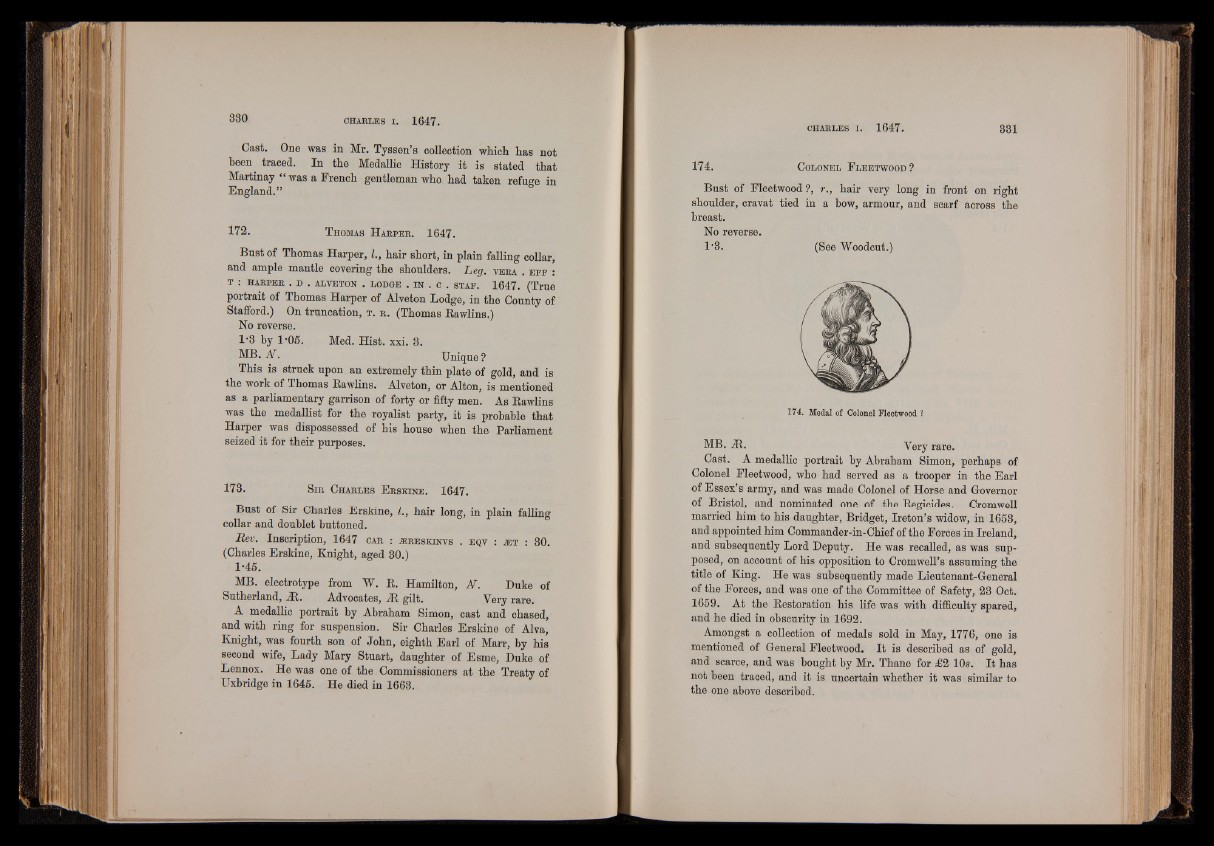
Cast. One was in Mr. Tyssen’s collection which has not
been traced. In the Medallic History it is stated that
Martinay “ was a French gentleman who had taken refuge in
England.”
172. T homas H a r p e r . 1647.
Bust of Thomas Harper, I., hair short, in plain falling collar,
and ample mantle covering the shoulders. Leg. v era . e f p :
T : HARPER . D . ALVETON . LODGE . IN . 0 . STAE. 1647. (True
portrait of Thomas Harper of Alveton Lodge, in the County of
Stafford.) On truncation, t . r . (Thomas Rawlins.)
No reverse.
1*8 by 1-05. Med. Hist. xxi. 3.
MB. N . Unique ?
This is struck upon an extremely thin plate of gold, and is
the work of Thomas Rawlins. Alveton, or Alton, is mentioned
as a parliamentary garrison of forty or fifty men. As Rawlins
was the medallist for the royalist party, it is probable that
Harper was dispossessed of his house when the Parliament
seized it for their purposes.
173. S ir C h a r l e s E r s k in e . 1647.
Bust of Sir Charles Erskine, I., hair long, in plain falling
collar and doublet buttoned.
Rev. Inscription, 1647 car : ^ r e sk in v s . eq v : .¿e t : 30.
(Charles Erskine, Knight, aged 30.)
1-45.
MB. electrotype from W. R. Hamilton, N . Duke of
Suthe rland,^. Advocates, JR gilt. Very rare.
A medallic portrait by Abraham Simon, cast and chased,
and with ring for suspension. Sir Charles Erskine of Alva,
Knight, was fourth son of John, eighth Earl of Man-, by his
second wife, Lady Mary Stuart, daughter of Esme, Duke of
Lennox. He was one of the Commissioners at the Treaty of
Uxbridge in 1645. He died in 1663.
174. C o lo n e l F l e e t w o o d ?
Bust of Fleetwood?, r., hair very long in front on right
shoulder, cravat tied in a bow, armour, and scarf across the
breast.
No reverse.
1*3. (See Woodcut.)
174. Medal of Colonel Fleetwood ?
MB. JR. Very rare.
Cast. A medallic portrait by Abraham Simon, perhaps of
Colonel Fleetwood, who had served as a trooper in the Earl
of Essex’s army, and was made Colonel of Horse and Governor
of Bristol, and nominated one of the Regicides. Cromwell
married him to his daughter, Bridget, Ireton’s widow, in 1653,
and appointed him Commander-in-Chief of the Forces in Ireland,
and subsequently Lord Deputy. He was recalled, as was supposed,
on account of his opposition to Cromwell’s assuming the
title of King. He was subsequently made Lieutenant-General
of the Forces, and was one of the Committee of Safety, 23 Oct.
1659. At the Restoration his life was with difficulty spared,
and he died in obscurity in 1692.
Amongst a collection of medals sold in May, 1776, one is
mentioned of General Fleetwood. It is described as of gold,
and scarce, and was bought by Mr. Thane for £2 10s. It has
not been traced, and it is uncertain whether it was similar to
the one above described.